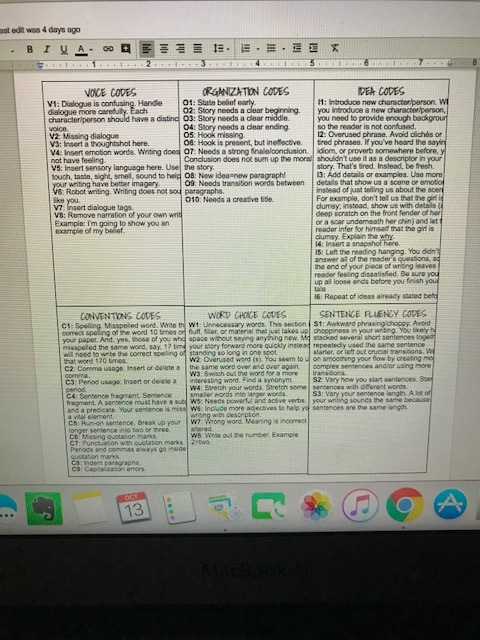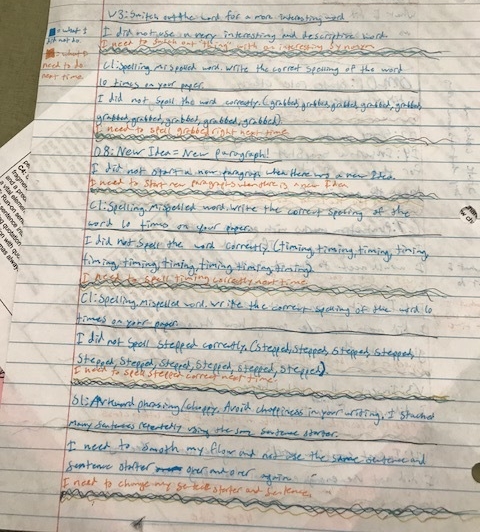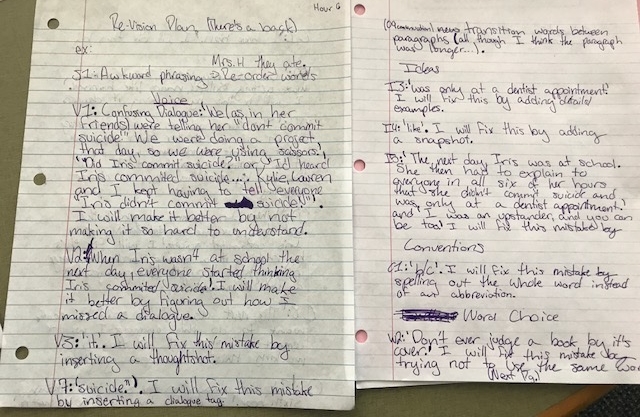Completely Change How You Grade With Rubric Codes
Cracking the Grading Code with Rubric Codes
This started on a Saturday, the Saturday before the Monday when I had to hand back rough drafts to my students. I wanted no part of them. I wanted nothing to do with them. Glancing at my comfy blanket and cup of coffee, I was a human replica of the emoji "ugh." Not wanting to embrace my stack of papers, I started texting a fellow English teacher about her method of using rubric codes. She uses numbers to correspond with different points on a rubric that come up over and over. We have had this discussion before, yet, I was resistant because I had always wanted to follow "traditional" feedback routes. Things I love: ink over typeface, writing in the margins, and seeing a child's face go, "You spent alllll that time on my paper?" Yes, yes I did. I have had many conversations about the writing process lately because it seems as ELA teachers, we all tackle this beast differently. I am not willing to budge on giving feedback on rough drafts, even though some instructional models no longer call for this step in the process. Rubric codes never seemed to fit...until it did.
Yet, rubric codes are not a new phenomenon to the English Teacher world, let alone the teacher of writing. Two of my favorite bloggers, Laura Randazzo from Solutions for the Secondary Classroom and Jennifer Gonzalez from Cult of Pedagogy, both have spoken on rubric codes to speed up grading. This post is not a sponsored post for Laura Randazzo's product in TeachersPayTeachers...but it should be. In fact, I would probably spend that 11.99 again not just because it was helpful to look at the work that Laura has put in with her coding system, but it inspired me to create my own way of coding in my English classroom. I'll get this out of the way. Click here to go to Laura's listing. It's worth it. I am still looking over her own rubrics, the E-Book that comes with these materials, and her helpful tips. I also love her vlogs. This is teacher collaboration at its finest. Also, Jennifer has an amazing FREE e-book about how to grade faster and smarter. Let's take each others' advice...and stay teaching.
I looked at Laura's product, and it was clear. This wasn't exactly accessible for middle schoolers...yet. Middle schoolers are new to the idea of feedback overall. Not saying that my elementary teacher counterparts are not giving feedback, but I have to condition them each year to the type of feedback that they receive on each paragraph and each paper. This feedback is more critical, more detailed, and just plain more in volume. It should be. They are moving up in the grading ranks. However, I have always followed this process.
Prewriting
Drafting
Feedback from me
Revising and editing/Peer review/Conferencing
Drafting
Revising and editing/Peer review/Conferencing
Publishing
Using rubric codes, I think, has the ability to change this whole process and the whole conversation during writing conferencing. Remember, this feedback is one of my main goals for the year as we talk more about writing in class, and I am taking less paper home overall. The end product was looking at Laura's example, and then making my own. This is what I came up with for the latest personal narrative essay:
This started on a Saturday, the Saturday before the Monday when I had to hand back rough drafts to my students. I wanted no part of them. I wanted nothing to do with them. Glancing at my comfy blanket and cup of coffee, I was a human replica of the emoji "ugh." Not wanting to embrace my stack of papers, I started texting a fellow English teacher about her method of using rubric codes. She uses numbers to correspond with different points on a rubric that come up over and over. We have had this discussion before, yet, I was resistant because I had always wanted to follow "traditional" feedback routes. Things I love: ink over typeface, writing in the margins, and seeing a child's face go, "You spent alllll that time on my paper?" Yes, yes I did. I have had many conversations about the writing process lately because it seems as ELA teachers, we all tackle this beast differently. I am not willing to budge on giving feedback on rough drafts, even though some instructional models no longer call for this step in the process. Rubric codes never seemed to fit...until it did.
Yet, rubric codes are not a new phenomenon to the English Teacher world, let alone the teacher of writing. Two of my favorite bloggers, Laura Randazzo from Solutions for the Secondary Classroom and Jennifer Gonzalez from Cult of Pedagogy, both have spoken on rubric codes to speed up grading. This post is not a sponsored post for Laura Randazzo's product in TeachersPayTeachers...but it should be. In fact, I would probably spend that 11.99 again not just because it was helpful to look at the work that Laura has put in with her coding system, but it inspired me to create my own way of coding in my English classroom. I'll get this out of the way. Click here to go to Laura's listing. It's worth it. I am still looking over her own rubrics, the E-Book that comes with these materials, and her helpful tips. I also love her vlogs. This is teacher collaboration at its finest. Also, Jennifer has an amazing FREE e-book about how to grade faster and smarter. Let's take each others' advice...and stay teaching.
I looked at Laura's product, and it was clear. This wasn't exactly accessible for middle schoolers...yet. Middle schoolers are new to the idea of feedback overall. Not saying that my elementary teacher counterparts are not giving feedback, but I have to condition them each year to the type of feedback that they receive on each paragraph and each paper. This feedback is more critical, more detailed, and just plain more in volume. It should be. They are moving up in the grading ranks. However, I have always followed this process.
Prewriting
Drafting
Feedback from me
Revising and editing/Peer review/Conferencing
Drafting
Revising and editing/Peer review/Conferencing
Publishing
Using rubric codes, I think, has the ability to change this whole process and the whole conversation during writing conferencing. Remember, this feedback is one of my main goals for the year as we talk more about writing in class, and I am taking less paper home overall. The end product was looking at Laura's example, and then making my own. This is what I came up with for the latest personal narrative essay:
I like that the feedback is categorized. I like that it is simple to understand. I like that even if it is not simple to understand, students can communicate in a way to tell me they do not understand. It has changed my view on grading.
Change #1: Common Language for Feedback
Rubric codes answers a variety of questions and issues that seem to work well with the writing process, but even better when teaching young writers. I took the Six Traits of Writing and made it accessible for students to read their feedback. The six traits of writing are as follows:
Voice
Organization
Ideas
Conventions
(Excellent) Word Choice
Sentence Fluency
These six traits apply to all writing genres. I am in my 8th year of teaching, and it has taken this long to provide a way for students to understand their feedback, and to also provide me as their teacher a data driven method of understand where they do and do not understand the mistakes in the writing. I can now say, "Susie struggles with sentence fluency codes" or "Bobby cannot organize a clear beginning." This has eliminated shooting into the dark. I have always given TONS of feedback. I have always helped students with their writing. I have never done it efficiently. Even, when I tried to use google forms and was able to leave voice feedback...it felt like cheating.
Change #2: Students Can Identify Mistakes
This one seems like it should be obvious. However, I would spend hours pouring over essays to write feedback and lines and dashes. And students would then spend hours trying to figure out what I was trying to say (My handwriting is not pretty). I had to come to the conclusion that students did not necessarily know what they were fixing on each draft. I was helping them, sure. However, could they isolate the problem and better yet, what happens if they don't know how to fix the problem? Would I ever know unless they told me? It is safe to say it might be negligent on behalf of the teacher to assume that students will always know how to use their voices. After all, aren't we supposed to help them find their voice? In writing and in life? One of the biggest ah-ha moments of the teaching of writing is when students realize a mistake and are empowered to figure out the why of the mistake. My goals are to get more specific about how I talk about feedback overall. Example of a given writing conference before and after:
1.) BEFORE: (Reads passage twice) What sounds different? Doesn't sentence B sound better? Yes, reword that sentence.
2.) AFTER: There is an issue of sentence fluency here. Let me read it out loud. See how it sounds choppy? What would you do to fix it? You could reword that sentence, or you could also change this word to a synonym to avoid repeating it a lot.
See? We call writing by its name. We know it, but we just have to introduce it to students in a way that it speaks their language, too.
Here are some resulting revision/editing plans:
Change #3: Time is Money
15-17/hour. Depending on the level of coffee. Before rubric coding, I could maybe sneak out 10-12 essays per hour. Let's break down the math a little bit, just so I can take a moment to feel good.
17/hour=3.52 minutes per essay
12/hour=5 minutes per essay
110 Advanced Personal Narratives on a Sunny Saturday? 387.2 minutes vs. 550 minutes. Rather, 6.5 hours of grading compared to 9 hours of grading. That 2.5 hours saved is time to spend with my family, to watch TV, to rejuvenate, and to relax-all without giving up my writing process standard of grading rough drafts. When I say time is money, the currency is giving quality feedback without dying as a teacher. I always tell my preservice teachers, find their currency and you will be able to establish rapport. My currency? Time saved, coffee, husband time, and naps. That is worth more than money. It is also worth the sanity to continue the job of teaching writing.
The time is in not writing out the comments. This isn't less feedback I am providing, it is more efficient. I highlighted lines of text that I thought were amazing. When breaking down the codes, I had an Oprah gif behind me where she is really excited to be giving away free stuff. I was really excited during moments of their writing. This is one area that I think I can make more specific and real to them. However, I also know that giving positive feedback is a weakness I am working on. It is easy to be negative, but nobody needs all criticism. We need some sunshine sometimes, too.
Next Steps
For final drafts coming in, I am going to have them resubmit their revision plans and drafts to put in their writing portfolios. I am also going to have them name the 3 codes they want feedback on for final drafts. Because in theory, I have already given them feedback on the draft. Using just these three codes, I can provide even more efficient feedback for final drafts. Students also have some choice and autonomy in what feedback they receive. It is because they want the feedback that they will be getting the feedback. This is also a critical piece in the writing process to teach students that feedback is good. Criticism can be good. Mistakes are proof we gave it a go.
I am going to use the same codes for general errors for all genres of writing. Our next essay is an argumentative piece after reading a novel. I am going to focus on this being a text connections essay where they use text evidence to explain connections. I am curious to see how much easier the revision plans are with the codes, and the progression of student writing. In the meantime, I am not dreading the next stack of papers.
Feel inspired and want to make your own codes? Here are links to my code sheets. You can make a copy and make it work for your own assignments!









